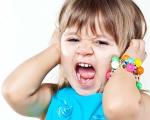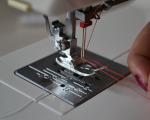We make a bunny using the quilling technique. Quilling Master Class: Chicken and Easter Bunny
The popularity of quilling is growing day by day and therefore many people are now interested in how to make various crafts, cards or wall panels out of paper. In today's tutorials for beginners, we will tell you how to make a paper hare.





In this small master class for beginners, we invite you to make a beautiful bunny for the New Year using quilling! Such an original shiny figurine will be a wonderful decoration for the New Year tree or holiday table:
To create a bunny using the quilling technique you will need:
- scissors;
- accessories for paper rolling;
- pencil;
- ruler;
- white plasticine;
- glue;
- adhesive gel with silver glitter;
- double-sided bright blue colored paper;
- pointed silver rhinestones – 4 pcs.
Educational quilling for beginners using the bunny quilling technique. First you need to make the body of the bunny. To do this, you need to cut 4 strips of blue paper. Their length should be 30 cm and width 5 mm. These strips must be glued together to form one large strip. Then you will need to twist it into a spiral using a quilling tool or a regular toothpick.
After this, the roll must be shaped into an oval. The tail, head and hind leg of the bunny are made in the shape of a drop:

It is formed from a tight spiral. The bunny's head will be twisted from a strip 60 cm long. To form the hind leg, you will need a piece of colored paper 30 cm long. The bunny's tail is made from a piece equal to 15 cm. The bunny's ears are shaped like an “eye”. In order to twist 1 ear, you will need a piece of paper 30 cm long. For the front leg of a bunny you will need 1 strip equal to 30 cm. First, it will need to be twisted into a tight spiral, then squeezed in the middle and folded on one side. To make sure that you have twisted all the parts correctly, you can look at the photo:

After making sure that all the elements are ready, you can begin to assemble the bunny step by step. To do this, you first need to glue the head, tail and paws to the body of the animal, and then attach the bunny ears to the head. After the hare dries, you will need to insert rhinestones into it. Since the hare made using this short instruction is double-sided, rhinestones must be inserted on both sides. That is, 2 instead of eyes and 2 in the center of the body:

To prevent the rhinestones from falling off, they are attached to pieces of plasticine, which is inserted into the center of the twisted parts. After the rhinestones are inserted, you will need to check the stability of the bunny. He should stand straight on his paws. If the hare wobbles, you can use it as a sling. To make the hare look more elegant, it needs to be additionally decorated with adhesive gel with glitter. It is applied along the outer edge of the toy:
A self-made bunny can be placed on a holiday table, hung on a Christmas tree, or simply given as a gift to one of your friends. Such an unusual souvenir will be a pleasant surprise for your guests!
Lesson for beginners: twisting a bunny
A cute white hare made of paper can be an original gift for Valentine's Day or a pleasant surprise for a birthday. They can be used to decorate a greeting card or gift box!
To twist a picture with a bunny you will need:
- glue;
- pale pink half-cardboard;
- white and pink paper cut into strips;
- pink gel pen;
- quilling kit with template;
- plastic eyes.
Let's start with a detailed lesson for beginner paper rollers. The work will take place in stages. And we will begin with a description of the technique for creating the head. Making a head for a bunny is very simple. To form it, you need to take two white stripes, glue them together and twist them into a tight roll. The finished spiral must be secured with glue.


The bunny's body should be larger than its head, so we will make it from three strips connected with glue. The scheme of actions will remain the same as when creating the head:

Even novice craftswomen know that in quilling most of the parts consist of spirals. Some of them remain in their original form, while others take on the shape of a droplet or an eye during the process. The bunny ears will also consist of 2 spirals:

However, unlike the head and body, they need to be fixed with glue only when they “unravel” slightly. To make the hare look natural, its ears need to be given an elongated shape.
The bunny has pink inserts in the middle of his white ears. They are made in the same way as the ears themselves, but smaller in size. They should be 2 times smaller than the ears themselves!


Now you need to twist the 2 lower legs in the shape of leaves:

After this, you can make the upper legs for the bunny:

The hare is made in a girly style, so the background for it should be pinkish:

Quilling a hare for beginners is almost complete. Now all the parts need to be glued to the base. It is best to start gluing blanks from the head and torso:


Then all the other parts are glued one by one:
Notice that the pink inserts are glued on top of the white ears!
When all the details are in place, you will need to decorate the muzzle. To do this, you first need to attach the plastic eyes:

You can make the eyes yourself. To do this, you need to roll rolls with a black core and white edges. The bunny's nose will be in the form of a pink spiral, and the mouth can be drawn with a pink helium pen.
To complement the image of the “glamorous” bunny, you can additionally decorate the paper animal with a small bow:
Video master class: Cute bunny
To make a picture with a hare using the popular quilling technique, you can also watch a short video clip. In it, the master first glues the outline of the hare, and then fills it with twisted parts. It will be difficult for novice craftswomen to make such a picture without preparation, so before starting work we recommend that they complete a small sketch. This will make the task much easier and perhaps even encourage the emergence of a new interesting idea from quilling!
The first stage of quilling creativity for children who are beginning to do needlework is making all the elements of the figurine. The collected animals can be used in theatrical role-playing games. The size of the finished figures is up to 18 cm in height.
Description of "Quilling "Bunny"
Paper spirals made from corrugated cardboard allow you to assemble 3D figures from them, revealing the color and texture of the paper, thereby emphasizing the complexity of the work being performed. Nothing can compare to the joy of a child holding his creation in his hands, in which a piece of his soul is invested, and seeing the admiring glances of friends and relatives when receiving such a gift!Colored corrugated cardboard cut into strips of 1 cm is a very convenient material for children's creativity in the quilling style. It is easy and pleasant to work with, the material holds its shape well and has a bright color.
The first stage of creativity using quilling technology is the production of all elements of the figurine. Volumetric parts are coated with glue from the inside. The second stage is gluing the parts together.
3D figures are used to decorate a room, and also as a pendant on a chandelier, a festive paper garland or a New Year tree (a loop made of corrugated cardboard or rope is easily glued on).
You can buy "Quilling "Bunny" ("Bunny") with delivery.
Contact our specialists for free consultation on the use of the product at
A great idea for a gift to relatives or friends is these cute souvenirs - a chicken and a hare. Let them bring only joy and goodness.
To work you will need:
- 1 yellow corrugated strip 1 cm by 50 cm;
- 1 red corrugated strip 1 cm by 50 cm;
- 10 yellow stripes 0.5 cm by 50 cm (or 1 cm by 50 cm);
- yellow cardboard;
- eyes (can be cut out of black and white paper);
- PVA glue, scissors, needles.
We cut out the template - the egg, lay out the outline from the yellow corrugated strip, insert the needles into the corrugated loops

We secure the ends of the strip.

Using the beehive technique we twist 10 strips. About 8 pieces went on the body and 1 (even less than one strip) on the wings. You can see how to twist curls in a master class about monkey.

Filling the middle.

If there are voids and you don’t like them, then cut one strip into separate elements.

And fill in the holes in the drawing.

Carefully coat with glue. We need to go over the curls and where they touch the walls with a brush. But do not allow the glue to leak onto the front side. If the paper strips are 1 cm wide, then the curls will be flush with the sides.

The glue will dry and become transparent. You can leave it like this, the figure will turn out very delicate.

You can glue the back wall from cardboard of a matching color.

This way.

We cut off two red corrugated strips of 10 cm each. These are the paws. We bend and glue.

We cut off two yellow corrugated strips approximately 7-8 cm long. These are the wings.

For the scallop there is still about 7 cm and two triangles - the beak.

We collect chicken.

You can also make an Easter Bunny.




Hello blog readers! In today's quilling master class I would like to present to your attention the making of a template - the Easter bunny. With this template you can make many different decorations for the Easter holidays. By making the same bunny, but decorating it with different elements, you can create unique and interesting Easter crafts for yourself and as gifts for your family and friends. Use my quilling master class with a detailed description and step-by-step photographs of making a craft - a DIY Easter bunny made of paper.
Materials:
- Paper ribbons 7 mm, length 29.5 cm, density 80 g/m2: white
- Paper ribbons 3 mm, length 29.5 cm, density 80 g/m2: white
- Paper ribbons 1.5 mm, length 29.5 cm, density 80 g/m2: white, pink, gray and light pink
- Scissors
- PVA glue
- Glue gun
- Twisting tool
- Quilling ruler
- Eyes (diameter 10 mm)
- Green fabric tape 4mm wide
- Silver glitter thread

We twist 2 rolls of white paper tapes 7 mm wide with a diameter of 40 mm (head) and 46 mm (torso). We glue the rolls on one side with PVA glue.

Glue the rolls together with a glue gun.

We make 2 drops from white paper ribbons 7 mm wide (the diameter of the loose roll is 22 mm). We glue the droplets on one side with PVA glue.


We make 2 more drops from white paper ribbons 7 mm wide (the diameter of the loose roll is 25 mm). We glue the elements on one side with PVA glue.

Glue the droplets (legs) to the body with a glue gun.

We twist 2 rolls of white paper ribbons 1.5 mm wide with a diameter of 12 mm. We form the rolls into a half ball and glue them on the inside with PVA glue.

Glue the elements with a glue gun.

We make a triangle from pink paper ribbons 1.5 mm wide (the diameter of the loose roll is 8 mm).

Glue the mouth with a glue gun.

We make a triangle from gray paper ribbons 1.5 mm wide (the diameter of the loose roll is 9 mm).

Glue the nose with a glue gun.

We twist 2 rolls of light pink paper ribbons 1.5 mm wide with a diameter of 9 mm.

Glue the cheeks with a glue gun.

We take purchased eyes.

Glue on the eyes.

We make elements, as in the photo, from white paper ribbons 3 mm wide (the diameter of the loose roll is 28 mm).

We give the elements volume and glue them on one side with PVA glue.

Once again we make the same elements as in the photo, only from light pink paper ribbons 1.5 mm wide (the diameter of the loose roll is 25 mm).

Glue the pink elements into the middle of the white elements with PVA glue.

Glue the ears with a glue gun.

Glue the silver thread. We also glue a bow made of green fabric ribbon 4 mm wide. Gluing a bow strengthens the connection between the head and body.
The paper Easter bunny is ready! Now using this template you can experiment with decorations and colors.















Thank you for your attention!



